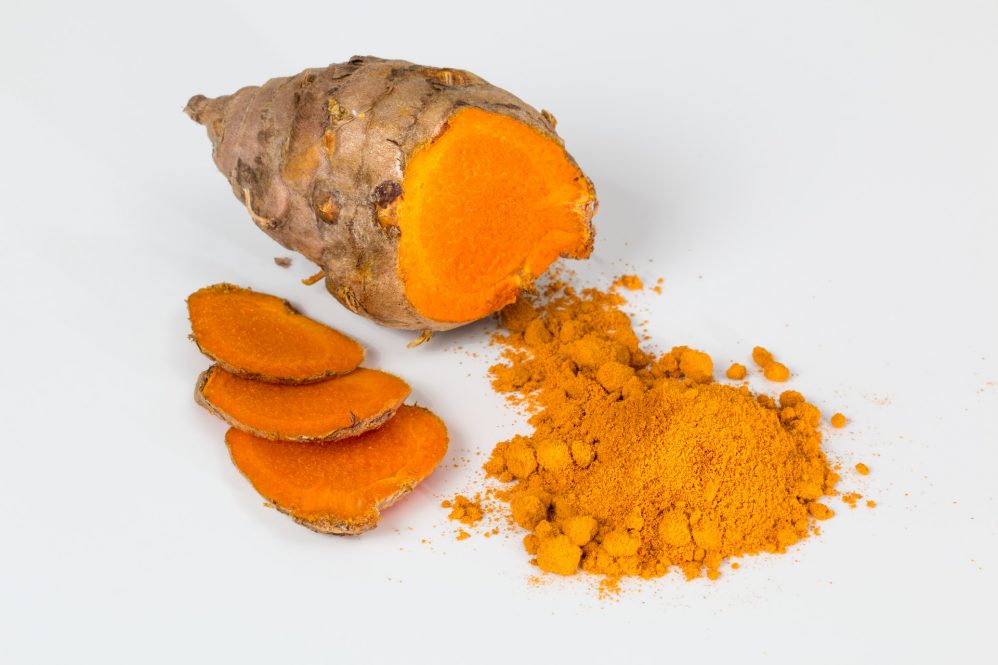Some of the ingredients in your kitchen cabinets could complement the function of those in your medicine cabinet. Neutraceutical foods, or those with natural healing properties, are becoming an increasingly popular part of medical treatment.
Oh Sung Kwon, assistant professor of kinesiology in the College of Agriculture, Health, and Natural Resources, is working on a grant from the National Institute of Food and Agriculture to test if a component in the spice turmeric, widely used in dishes throughout Asia and the Middle East, can improve cholesterol levels for people taking statins and alleviate painful side effects.
Statins are a class of drugs that can help lower one’s cholesterol and risk for cardiovascular disease morbidity and mortality. Statins effectively block the production of cholesterol by inhibiting the activity of the enzyme Hydroxy-methyl-glutaryl Coenzyme A reductase (HMG-CoA reductase).
Despite their proven effectiveness, 50% of high-risk patients eligible for statins are untreated. Among those taking statins, the adherence rates are only between 30% to 40% after the first year.
The most common reason people reportedly stop taking statins are statin-associated muscle symptoms (SAMS), which include muscle aches, pain, and stiffness.
There are currently very few treatments for SAMS and there is no conclusive clinical data supporting the effectiveness of any of these treatments.
To address this significant lack, Kwon will investigate the possibility of using curcumin, the main active ingredient in turmeric, to treat SAMS. Curcumin has antioxidant, anti-inflammatory, and pain-relieving properties. Curcumin supplements have already been used effectively to treat muscle symptoms associated with osteoarthritis, rheumatoid arthritis, acute injury, and fibromyalgia.
Curcumin is a particularly attractive candidate because it is low-cost and can simply be purchased over the counter, without a prescription.
Curcumin is a safe and efficacious nutraceutical that would be more affordable as well as agriculturally and environmentally sustainable than traditional pharmaceutical treatments for SAMS.
Turmeric grows well in a variety of indoor and outdoor settings. Turmeric has a long growing season, lasting from 120 to 360 days a year. There are no known diseases or pests that attack the crop. Turmeric can easily be grown in Connecticut, supporting agriculture in the state.
“Currently, the only effective treatment of statin-induced myopathy is the discontinuation of statin use in patients affected by muscle aches, pains and elevated CK levels,” Kwon says. “Our preliminary data revealed reduced mitochondria function and increased oxidative stress from mitochondria during exercise in patients with SAMS. So hopefully, the antioxidant properties in curcumin will attenuate statin-induced myopathy.”
In addition to mitigating SAMS, curcumin can also improve cholesterol levels in the blood by lowering LDL-C the kind of cholesterol associated with higher cardiovascular health risk, and raising HDL-C, which is associated with lower risk of heart disease.
Kwon will recruit 40 patients with SAMS and randomize treatment with either curcumin or a placebo in combination with regular statins. He will evaluate reductions in symptom presence and severity in patients. Kwon hypothesizes that combined curcumin and statin treatment will be more effective at lowering LDL-C than those taking only statins.
Kwon will also assess muscle oxygenation, tested through handgrip exercises. These exercises demonstrate how well the mitochondria, which provide energy to cells, are functioning.
By reducing the impact of SAMS, Kwon hopes this approach can help improve statin adherence and thus improve the overall health of patients with high cholesterol.
Kwon holds a Ph.D. in exercise physiology from the University of Florida, Gainesville. His research interests include mitochondria, bioenergetics, musculoskeletal physiology, and cardiovascular physiology.



